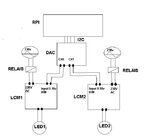MtzJhNO
Newbie level 3
Hi. I have a DAC board (for a raspberry PI) that uses a MCP4812 for analog outputs (board diagram: https://www.horter.de/doku/i2c-hs-analog-output_sp.pdf) The outputs of the DAC are used to controls the 0-10v input of a Meanwell LCM LED driver (for controlling LED downlights in my house). FYI, the connection schema looks like this:

Now, sometimes a glitch appears in which the channels of the DAC are magically (re)set to 0v. This happens for ex. when first driver1/LED1 is turned on. Output of CH0 is set to 100% (all good, LED is at max light value). Next driver2/LED2 connected to CH1 is turned on. When doing so the other channels of the DAC (CH0,2,3) are now (re)set to 0V. Meaning that LED1 which was previously at 100% suddenly drops to its minimum. To make things worse, this happens 'randomly' like 2 out of 10. After replacing and testing almost everything I found out that it must be the driver which is disrupting the output of the other channels of the DAC through it's "0-10v connection" from the moment it is turned on. When the 0-10v is disconnected of the driver that is toggled the outputs remain at their configured value.
To test this theory I was thinking on try placing a signal repeater that has galvanic separation between the DAC output and the LCM. It would then 'copy' the 0-10v signal from the DAC ouput to the driver input. However, the best I can come up with is a Wago 857-412. This is a rather expensive solution to a) test a theory b) even if it works I need one for each channel.
So, my question is, is there perhaps a cheaper solution for such a separator? Other ideas on how to tackle this are more than welcome.
Thanks for reading.

Now, sometimes a glitch appears in which the channels of the DAC are magically (re)set to 0v. This happens for ex. when first driver1/LED1 is turned on. Output of CH0 is set to 100% (all good, LED is at max light value). Next driver2/LED2 connected to CH1 is turned on. When doing so the other channels of the DAC (CH0,2,3) are now (re)set to 0V. Meaning that LED1 which was previously at 100% suddenly drops to its minimum. To make things worse, this happens 'randomly' like 2 out of 10. After replacing and testing almost everything I found out that it must be the driver which is disrupting the output of the other channels of the DAC through it's "0-10v connection" from the moment it is turned on. When the 0-10v is disconnected of the driver that is toggled the outputs remain at their configured value.
To test this theory I was thinking on try placing a signal repeater that has galvanic separation between the DAC output and the LCM. It would then 'copy' the 0-10v signal from the DAC ouput to the driver input. However, the best I can come up with is a Wago 857-412. This is a rather expensive solution to a) test a theory b) even if it works I need one for each channel.
So, my question is, is there perhaps a cheaper solution for such a separator? Other ideas on how to tackle this are more than welcome.
Thanks for reading.